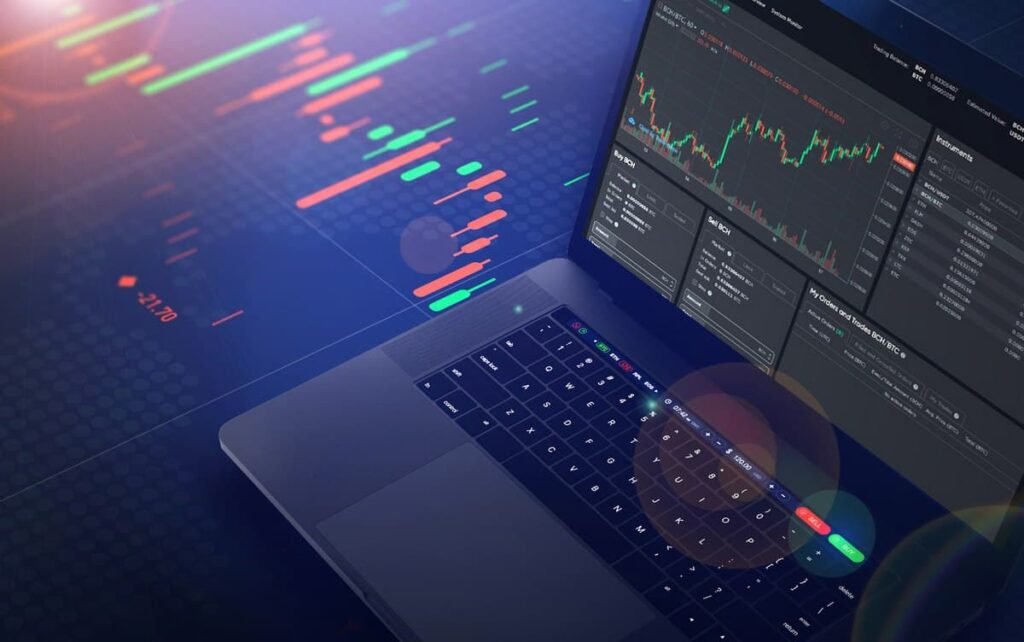The cryptocurrency lending landscape has evolved dramatically, with overcollateralized crypto lending platforms emerging as the gold standard for secure digital asset financing. These platforms require borrowers to deposit cryptocurrency worth more than the loan amount, creating a safety net that protects lenders while enabling passive income generation. Unlike traditional banking systems, overcollateralized crypto lending platforms operate on blockchain technology, offering transparency, efficiency, and global accessibility.
As the DeFi ecosystem matures, understanding how these platforms work becomes crucial for investors seeking to maximize the potential of their crypto holdings while maintaining security. Whether you’re a seasoned crypto investor or exploring passive income opportunities, these platforms represent a fundamental shift in how we approach digital asset management and wealth generation.
What Are Overcollateralized Crypto Lending Platforms
Overcollateralized crypto lending platforms are decentralized finance (DeFi) protocols that facilitate cryptocurrency loans, requiring borrowers to deposit collateral exceeding the loan value. This mechanism, typically ranging from 120% to 300% collateralization ratios, ensures lenders receive protection against market volatility and default risks.
These platforms operate through smart contracts, automatically executing loan terms without the need for intermediaries. When borrowers deposit their cryptocurrency as collateral, they can borrow a portion of that value in stablecoins or other cryptocurrencies. The excess collateral serves as a buffer against price fluctuations, protecting lenders’ principal investments.
The overcollateralization model addresses cryptocurrency’s inherent volatility by requiring substantial security deposits. If collateral values drop below predetermined thresholds, the platform automatically liquidates positions to repay lenders, maintaining system stability and protecting investor funds.
How Overcollateralized Crypto Lending Works
The Lending Process
The lending mechanism begins when users deposit cryptocurrency into liquidity pools on overcollateralized crypto lending platforms. These deposits earn interest as other users borrow against their collateral. Lenders receive platform-specific tokens representing their deposit shares, which accrue interest over time.
Borrowers must deposit cryptocurrency worth significantly more than their desired loan amount. For example, to borrow $1,000 in stablecoins, a borrower might need to deposit $1,500 worth of Ethereum. This 150% collateralization ratio protects lenders against moderate price declines.
Smart contracts continuously monitor collateral values using oracle price feeds. When collateral ratios approach dangerous levels, the system triggers margin calls, requiring borrowers to add more collateral or partially repay loans—failure to respond results in automatic liquidation.
Interest Rate Mechanisms
Interest rates on overcollateralized crypto lending platforms fluctuate in response to supply and demand dynamics. High demand for borrowing increases rates, benefiting lenders, while abundant liquidity decreases rates. Most platforms use algorithmic models to adjust rates in real-time.
Some platforms implement tiered interest structures, offering higher rates for longer lock-up periods or larger deposits. Premium features might include reduced borrowing rates for holding platform tokens or participating in governance activities.
Top Overcollateralized Crypto Lending Platforms in 2025
Aave The DeFi Lending Pioneer
Aave stands as one of the most established overcollateralized crypto lending platforms, offering multiple cryptocurrency markets with competitive interest rates. The platform supports over 30 different cryptocurrencies and provides both stable and variable interest rate options.
Key features include flash loans, credit delegation, and rate switching capabilities. Aave’s safety module, powered by AAVE token staking, provides additional security through protocol insurance. The platform’s governance token holders can vote on risk parameters and new market additions.
Compound Simple and Effective
Compound pioneered algorithmic interest rate determination in DeFi lending. This overcollateralized crypto lending platform automatically adjusts rates based on utilization ratios, creating efficient markets for both lenders and borrowers.
The platform’s cToken system represents user deposits, automatically compounding interest earnings. Compound’s governance model allows COMP token holders to propose and vote on protocol changes, including new market listings and risk parameter adjustments.
MakerDAO The Stablecoin Generator
MakerDAO operates differently from traditional lending platforms by enabling users to mint DAI stablecoins against cryptocurrency collateral. This overcollateralized system requires users to deposit at least 150% collateral value to generate DAI tokens.
The platform’s stability fee acts as the borrowing interest rate, while DAI holders can earn interest through the DAI Savings Rate (DSR). MakerDAO’s decentralized governance system, controlled by MKR token holders, manages risk parameters and system stability.
Benefits of Using Overcollateralized Crypto Lending Platforms

Enhanced Security Through Excess Collateral
The primary advantage of overcollateralized crypto lending platforms lies in their robust security model. Excess collateral requirements create multiple layers of protection against market volatility and borrower defaults. This structure has proven remarkably resilient during cryptocurrency market downturns.
Lenders benefit from automated liquidation mechanisms that protect their principal investments. Smart contracts execute liquidations without human intervention, ensuring rapid response to market conditions. This systematic approach minimizes counterparty risks common in traditional lending.
Passive Income Generation
Cryptocurrency holders can generate steady passive income by depositing assets into overcollateralized crypto lending platforms. Interest rates often exceed traditional savings accounts, providing attractive yields on digital assets that might otherwise remain idle.
Compound interest mechanisms on many platforms automatically reinvest earnings, accelerating wealth accumulation over time. Some platforms offer additional rewards through native token distributions, further enhancing total returns for patient investors.
Global Accessibility and Transparency
Unlike traditional banking systems, overcollateralized crypto lending platforms operate 24/7 without geographical restrictions. Anyone with cryptocurrency and internet access can participate, democratizing access to financial services globally.
Blockchain transparency allows users to verify all transactions and protocol operations independently. This openness builds trust and enables community-driven governance improvements, creating more resilient and user-focused platforms.
Risks and Considerations
Smart Contract Vulnerabilities
Despite thorough auditing, smart contracts powering overcollateralized crypto lending platforms may contain undiscovered vulnerabilities. Hackers continuously search for exploits, and successful attacks can result in significant fund losses for users.
Platform teams typically implement multi-signature wallets, time delays for critical changes, and insurance funds to mitigate these risks. However, users should only invest amounts they can afford to lose and diversify across multiple platforms.
Liquidation Risks for Borrowers
Borrowers face the risk of liquidation when collateral values decline rapidly. Overcollateralized crypto lending platforms automatically sell collateral to repay loans when ratios fall below maintenance levels, potentially forcing sales at unfavorable prices.
Market volatility can trigger cascading liquidations, where falling prices prompt additional sales, further depressing the market. Borrowers must carefully monitor their positions and maintain adequate collateral buffers to avoid liquidation penalties.
Also Read:Mutuum Finance The Next Big DeFi Lending Platform
Regulatory Uncertainty
The evolving regulatory landscape poses ongoing challenges for overcollateralized crypto lending platforms. Governments worldwide are developing frameworks for decentralized finance (DeFi) protocols.
Which could potentially impact platform operations and user access. Regulatory changes may impact platform functionality, token valuations, or availability in specific jurisdictions. Users should stay informed about regulatory developments in their regions and platform responses to changing compliance requirements.
Choosing the Right Platform for Your Needs

Evaluating Platform Security
When selecting overcollateralized crypto lending platforms, prioritize security features and track records. Look for platforms with comprehensive smart contract audits, bug bounty programs, and transparent security practices. Historical performance during market stress tests provides valuable insights into platform resilience.
Consider insurance coverage, emergency pause mechanisms, and governance structures that enable rapid response to threats. Platforms with longer operational histories and proven crisis management capabilities generally offer greater security assurance.
Comparing Interest Rates and Features
Interest rates vary significantly across overcollateralized crypto lending platforms, influenced by platform mechanics, token economics, and market conditions. Compare both lending and borrowing rates, taking into account how they fluctuate in response to market dynamics.
Evaluate additional features like governance token rewards, premium services, and platform utilities. Some platforms offer enhanced yields for long-term commitments or participation in ecosystem activities, which can potentially increase overall returns.
Assessing User Experience and Support
Platform usability has a significant impact on your lending experience. Evaluate interface design, mobile compatibility, and educational resources. Quality customer support becomes crucial when issues arise, particularly for new users navigating complex DeFi protocols.
Community engagement through forums, social media, and governance participation indicates platform vitality and user satisfaction. Active communities often provide valuable insights and support for platform users.
Future of Overcollateralized Crypto Lending
Technological Improvements
Overcollateralized crypto lending platforms continue to evolve with technological advancements. Layer 2 scaling solutions reduce transaction costs and improve user experience, while cross-chain protocols enable asset utilization across multiple blockchains.
Oracle improvements enhance price feed accuracy and reliability, reducing liquidation risks and improving platform stability. Advanced liquidation mechanisms and partial liquidations enable borrowers to maintain their positions during market volatility.
Institutional Adoption
Traditional financial institutions increasingly recognize the potential of overcollateralized crypto lending platforms. Institutional participation brings additional liquidity, stability, and legitimacy to decentralized finance (DeFi) lending markets.
Regulatory clarity will likely accelerate institutional adoption, as compliance frameworks provide certainty for large-scale participation. This institutional influx could significantly increase platform liquidity and reduce interest rate volatility.
Integration with Traditional Finance
The boundary between DeFi and traditional finance continues to blur as overcollateralized crypto lending platforms integrate with conventional financial systems. This convergence could lead to the creation of hybrid products that combine DeFi efficiency with traditional finance stability.
Central bank digital currencies (CBDCs) may eventually integrate with decentralized finance (DeFi) lending protocols, creating new opportunities for global financial inclusion and efficiency improvements.
Best Practices for Safe Lending
Risk Management Strategies
Successful participation in overcollateralized crypto lending platforms requires disciplined risk management. Diversify deposits across multiple platforms and asset types to reduce concentration risks. Never invest more than you can afford to lose, and maintain emergency funds outside DeFi protocols.
Regularly monitor platform developments, security updates, and market conditions. Set up alerts for significant price movements or platform announcements that might affect your positions. Stay informed about protocol governance decisions that could impact returns or risks.
Due Diligence Checklist
Before using any overcollateralized crypto lending platform, conduct thorough research. Verify smart contract audits, examine team backgrounds, and review platform governance structures. Understand liquidation mechanisms, fee structures, and withdrawal processes completely. Test platforms with small amounts initially to understand functionality and user experience. Gradually increase exposure as you become comfortable with platform operations and risk profiles.
Conclusion
Overcollateralized crypto lending platforms represent a revolutionary approach to digital asset management, combining security, transparency, and attractive yields in ways traditional finance cannot match. These platforms have demonstrated remarkable resilience and continue evolving with technological improvements and institutional adoption.
Success in crypto lending requires careful platform selection, thorough risk assessment, and disciplined portfolio management. By understanding the mechanics, benefits, and risks of overcollateralized crypto lending platforms, investors can make informed decisions that align with their financial goals and risk tolerance.
The future of DeFi lending looks promising, with continued innovation addressing current limitations while expanding accessibility and functionality. Whether you’re seeking passive income or exploring new financial opportunities, overcollateralized crypto lending platforms offer compelling alternatives to traditional investment vehicles.


